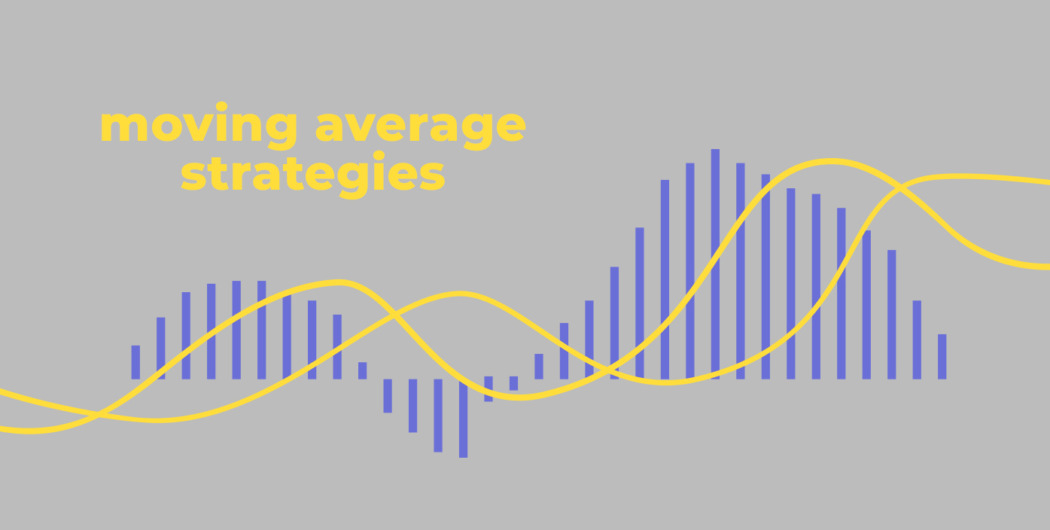

You may have read this article that covered the basics of the moving average indicator. Along with such standard implementation rules as a breakout and crossover, there are three other effective moving average trading strategies that can help you predict the price direction correctly.
To measure the effectiveness of the trading strategy, apply the Sharpe ratio, which is named after Nobel laureate William F. Sharpe. This ratio determines how much extra returns you can earn to offset the extra volatility of a riskier asset.
Do moving average strategies work?
The answer is yes. The moving average indicator is used alone and as a base for other indicators. However, to make the moving average work, you should set certain parameters.
What is a good moving average, and what is the best setting for a moving average?
The parameters depend on the timeframe. The most common periods that have proved their effectiveness are 9, 12, and 21 (intraday trading and scalping), as well as 50, 100, and 200 (longer-term positions).
MAs with a shorter period provide more signals but bear the risk of fake alerts. Longer-term MAs give fewer signals, but they are more reliable.
Below, you will find the most effective trading strategies that you can apply to most of your trades.
Envelopes
It’s one of the simple moving average strategies. Envelopes are bounds that are set at a certain percentage above and below an MA. The MA can be of any type, including simple, exponential, and average-weighted.
This strategy is mostly applied to longer-term timeframes and strong trends. If you trade on the daily chart, you should use envelopes with 10- to 100-day periods. The bands should be at the 1-10% distance from the MA. If you plan to apply intraday strategies, the envelopes are supposed to be less than 1%. For instance, on the 1-minute chart, the base MA should have a 20-minute period, and the envelopes will be 0.05%.
Rules:
- Entry. In the bullish trend, buy when the price rebounds up from the middle MA. In the bearish trend, sell when the price falls below the middle MA.
- Stop loss. Set a stop-loss order one pip below a just-formed swing for a buy position and one pip above the swing for a sell trade.
- Take profit. A take-profit order can be placed on the upper band for a long position and on the lower band for a short position. The number of pips you risk can differ. Therefore, you should adjust the take-profit level regarding this amount – it should be at least twice bigger than the amount you risk.
The envelope strategy should be set depending on the current market volatility, the instrument you trade, and the timeframe you trade on.
Ribbon
This strategy is applied for the trend change. You need to apply between eight and 15 exponential MAs on one chart. Using a large number of EMAs allows traders to determine both the strength and direction of the trend. A strong trend is characterized by a steeper angle of MAs and a wider distance between them.
Therefore, you can apply this trading approach to define entry points on the trend reversal.
- Entry. Find a market condition in which MAs are close to each other. The closer they are, the stronger the signal will be. During this period, the price will fluctuate within a narrow range. Open a long trade when the price rises above the upper boundary of the consolidation channel. Sell if the price falls below the lower boundary of the channel.
- Stop loss. Place a stop-loss order just below the lower band (long trade) and above the upper band (short trade).
Crossover is another option to apply the ribbon approach. You can apply a crossover strategy whenever there is more than one MA. When a shorter-term MA crosses above the longer-term, it’s a buy signal. Open a sell position when the shorter MA breaks below the longer one. Here, you need to define how many crossovers you need to confirm the signal.

MA + MACD
You can combine MAs and the MA-based MACD indicator.
Implement two MAs with different periods depending on the timeframe. Still, the strategy is more effective on hourly and daily charts. Therefore, use 50- and 100-period settings. The idea is to open a trade in the direction of the breakout of the moving average.
Rules:
- Entry. The price should break above both moving averages in the uptrend and below both MAs in the downtrend. The price should move by at least ten pips from the closest MA. Enter the position in the direction of a breakout only if the MACD indicator has formed at least five positive bars for the long position or at least five negative bars for the short trade. If the MACD condition isn’t fulfilled, you should wait for the next signal.
- Stop loss. Remember that the stop-loss order will reduce possible losses. It should be five bars below (buy trade) and five bars above the entry point (sell trade).
- Take profit. You should divide the exit into two steps. Exit half of the trade as soon as the price is twice the stop-loss order. At the same time, you should move the stop-loss level to the entry point (both trades). Exit the second half when the price falls ten pips below the 50-period MA (buy trade) and above by ten pips (sell trade).
Don’t apply the strategy if the price is between MAs.
Takeaway
There are numerous trading strategies based on the moving average. Also, MA forms several other indicators implemented in trading strategies, too. To find the best trading approach, practice different parameters depending on the market conditions (volatility and liquidity), the asset you trade, and the length of your trade.









